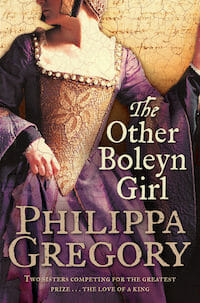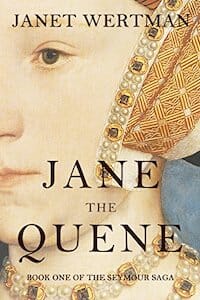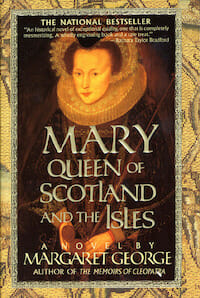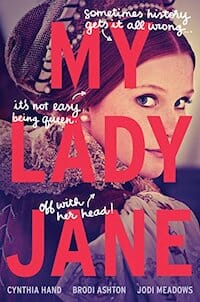Best Historical Fiction for Fans of the Tudor Clan

No matter what we do, no matter how many times we tell their stories, we can’t seem to get enough of England’s Tudor family. From feature films and prestige television series to successful Broadway musicals, we’re obsessed—with the man who almost broke the world with his desire to end his marriage, with the six very different women he made memorable only for the facts of their deaths (or divorces, as the case may be), with the son he was desperate to have, with the daughter who survived him and became one of the greatest monarchs who ever lived.
Why are their stories so fascinating? The political intrigue? The constant betrayals and backstabbing? The complicated women who deserved better than the man they married? The triumph of the young girl whose mother was perhaps most wickedly done by? Maybe all of the above.
Perhaps that’s why there’s a small cottage industry built around historical fiction based on the Tudor family, ranging from stories focused on Henry and relationships with his wives and daughters, to books focused on his larger extended family, including his royal (and not so royal) parents, grandparents, cousins, and more.
If you’re craving some Tudor-focused fiction, here are a few recommendations for places to start.
![]()
 The Tudor Court Series by Philippa Gregory
The Tudor Court Series by Philippa Gregory
If you’ve read any Tudor-based historical fiction, you’ve likely come across the works of Philippa Gregory. Though her mega-bestselling novel The Other Boleyn Girl is probably her most well-known title, her Tudor Court series spans 15 novels and features basically every prominent woman connected to the Tudor family, from Henry VII’s six wives and both his daughters, to his niece Mary Queen of Scots and his second cousin Margaret de la Pole.
Though these books are not what anyone might call even mostly historically accurate—the York women are vaguely presented as witches and a curse at the hands of their family is supposedly the reason Henry never manages a long-lived male heir—but they sure are fun to read. Full of drama, an entertaining array of female leads, and fast-paced storytelling, these may be the historical fiction equivalent of candy, but wow do they go down easy.
 The Six Tudor Queens Series by Alison Weir
The Six Tudor Queens Series by Alison Weir
Alison Weir is perhaps best known for her Tudor-focused nonfiction works such as The Six Wives of Henry VIII, The Lady in the Tower: The Fall of Anne Boleyn or The Children of Henry VIII, but her historical fiction is just as appealing, likely because it is so informed by her deep knowledge of the real-life period in which her stories take place.
Though her earlier novels such as Innocent Traitor and Captive Queen spin entertaining tales out of the lives of women such as Lady Jane Grey and Eleanor of Aquitaine, Tudor fans should run, not walk to check out her Six Tudor Queens series, which devotes entire novels to each of King Henry’s six wives: Katherine of Aragon: The True Queen, Anne Boleyn: A King’s Obsession, Jane Seymour: The Haunted Queen, Anne of Kleve: Queen of Secrets, Katheryn Howard: The Tainted Queen, and Katharine Parr: The Sixth Wife,/i>.
Each installment in the series explores the emotions and motivations of a group of often extraordinary women who are sadly all generally remembered only for the facts of their deaths, rather than their own accomplishments or desires in life. Weir’s books about Anne of Kleve, Katheryn Howard, and Katharine Parr are particularly excellent, simply because their subjects are so infrequently explored—especially in comparison to the first two of the six wives.
 Wolf Hall by Hilary Mantel
Wolf Hall by Hilary Mantel
Author Hilary Mantel’s trilogy about the rise and fall of Thomas Cromwell is remarkable for its immersive feel and deft grasp of the complex political intrigue of the Tudor Court. (Plus almost no one ever writes stories about Cromwell, whose rise from blacksmith’s son to Chancellor of England and right hand of the King himself was truly remarkable, both in its day and now.)
Both Wolf Hall and Bring Up the Bodies each won the prestigious Booker Prize and, depending on whose word you trust on the subject, the third and final novel of the trilogy The Mirror and the Light probably should have at least made the shortlist in the competition this year. (Though it is, admittedly, a bit less focused and more rambly than the rest.)
 Jane the Quene by Janet Wertman
Jane the Quene by Janet Wertman
The first installment in Janet Wertman’s Seymour Saga, which follows the story of Jane Seymour, her brother Edward, Duke of Somerset, and her son Edward, King of England, is intriguing in that its subject matter is so infrequently explored. (You can basically trip and hit a book about most of the other major Tudor family members, but since Jane is generally famous for both finally giving Henry a boy and conveniently dying immediately afterward, she often gets the short end of the stick.)
Though the story does explore some of the religious and political flashpoints that come to a head around Jane as a symbol as much as a person, Wertman sees Henry and Jane as a love match. And, as a result, there are more romance elements here than you might expect, just given how fiction tends to present this relationship.
But Werman’s story is at its most interesting when we see Jane attempt to balance her genuine emotions for Henry and her desire to be queen with her knowledge of what her rise will mean for Anne Boleyn, and whether her pious nature will allow her to essentially sign off on another woman’s death.
 The Beaufort Chronicles by Judith Arnopp
The Beaufort Chronicles by Judith Arnopp
As Henry VIII’s paternal grandmother and matriarch of the Tudor clan, Margaret Beaufort, had a tremendously outsize impact on her family and how they shaped England, particularly given the roles women were traditionally allowed to possess during this time. And yet far too many people don’t even know who she was. Judith Arnopp’s Beaufort Chronicles series aims to correct that, giving us a dramatized version of her very eventful life, which included four husbands, having a child when she was just fourteen, giving up that son, reclaiming him, and surviving not one but two wars.
Yes, the story takes some liberties with likely historical facts—particularly during Margaret’s early life, about which very little is known—but Arnopp is more than fair in her depiction of a woman that history tends to remember unkindly, despite her many accomplishments and obvious survivor’s heart.
 Mary Queen of Scotland and the Isles by Margaret George
Mary Queen of Scotland and the Isles by Margaret George
One of those books that it felt like everyone was reading in the late 1990s, Margaret George’s massive doorstopper about the life of Mary Queen of Scots remains as fascinating a read now as it was back then.
A dense, detailed read, it depicts Mary as a more mature and realistic figure than many of the other books that focus on the soapier aspects of her life. Fair warning, clocking in at nearly 900 pages, this one’s not for the faint of heart.
 My Lady Jane by Cynthia Hand, Brodi Ashton and Jodi Meadows
My Lady Jane by Cynthia Hand, Brodi Ashton and Jodi Meadows
A joyfully anachronistic bit of historical fiction about the infamous Nine Days’ Queen Lady Jane Grey, this novel reimagines her brief reign as a charmingly tongue-in-cheek shapeshifter romance. Instead of the struggle between Catholics and Protestants, England is torn between the Edoians, humans who shape-shift into animals, and the Verities, who loathe them, and the end result is a story in which Jane, her husband Guilford Dudley, and even King Edward VI himself all get happier endings than actual history affords them.
Whip-smart dialogue, droll humor, and a barrage of pop culture references make this a fun quick read, with tons of nods to the real-world history that the book’s story so gleefully ignores.
 ??The Secrets of the Tudor Court Series by Kate Emerson
??The Secrets of the Tudor Court Series by Kate Emerson
A series that’s sort of vaguely based on archetypes of the various mistresses that entertained King Henry VIII during his many (many) years of marital infidelity, Kate Emerson’s Secrets of the Tudor Court series is delightful for all the ways its not indebted to history and thereby free to chart its own path.
As much as we all love reading the stories of Henry’s wives, no matter how much we might delight in Catherine of Aragon’s piety or Anne Boelyn’s sparkle or Anne of Cleve’s intelligence, we already know their stories—and how they must all end. From The Pleasure Palace to By Royal Decree and The King’s Damsel these are scandalous, romantic tales whose endings are unknown and unwritten, full of political intrigue and forbidden relationships and everything we want from a story set in this particular era of history. (Even if none of these people technically existed.)
Lacy Baugher Milas is the Books Editor at Paste Magazine, but loves nerding out about all sorts of pop culture. You can find her on Twitter @LacyMB.